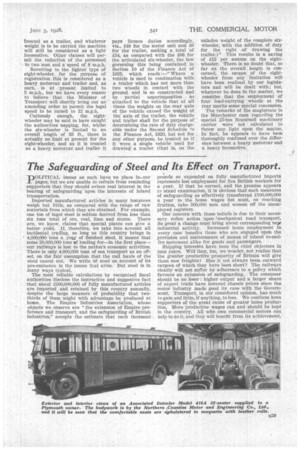THE LEGAL STATUS OF THE EIGHT-WHEELER.
Page 54

Page 55

If you've noticed an error in this article please click here to report it so we can fix it.
Some Important Points which Will Do Much Towards Removing any Misconceptions Regarding the Position of the Articulated Multi-wheeler.
TEM case concerning an articulated eight-wheeler, which was dealt with at the Manchester Police Court on May 21st and which we reported in our issue of last week, has brought into prominence a type of vehicle regarding the legal status of which there are apt to be misconceptions, and we hope in this article to be able to remove these; we shall also refer to some probable modifications of the law which will do still more to clarify the situation.
To begin with, it is necessary to point out that there are two distinct classes of this type of vehicle —that which can be registered as a heavy motorcar and the special type built for the conveyance of heavy machinery, etc., which has to be registered as a heaq locomotive.
The particular vehicles with which we shall deal are manufactured by Scammell Lorries, Ltd., 14, Holborn, London, E.C.1. The ordinary Scammell eight-wheeler weighs under 8 tons unladen, although the permissible weight is 9 tons 15 cwt., and as the legal total weight is 22 tons this gives a payload capacity of 14 tons.
The 25-ton Scammell, which was the one concerned in the prosecution to which we have referred, has to be licensed as a heavy locomotive, and there are then no restrictions upon its weight, but at present, under the Act of 1861, it must not travel at a speed greater than
2 m.p.h., and must have a third man in attendance. It is obvious that for a machine of this description, in which the weight is wonderfully , evenly distributed and the whole of the load is carried on rubber tyres, these restrictions are absurd, and, fortunately, the situation will:be entirely altered if and when the Road Traffic Bill is passed (and there is every probability that this will be brought forward during the next parliamentary session), for the provisions of the Bill permit a vehicle of this type to be licensed as a light locomotive (details of this are given in paragraph 13, page 2, of the Draft Bill), for the front of the vehicle will be treated as a locomotive and the carrier portion will be treated as a trailer, and whatever weight is to be carried the machine will still be considered as a light locomotive. Other clauses will permit the reduction of the personnel to two men and a speed of 8 m.p.h.
Reverting to the lighter type of eight-wheeler, for the purpose of registration this is considered as a heavy motorcar and trailer and, as such, is at present limited to 5 m.p.h., but we have every reason to believe that the Minister of Transport will shortly bring out an amending order to permit the legal speed to be raised to 12 m.p.h.
Curiously enough, the eightwheeler may be said to have caught 1 he authorities napping, for, whilst the six-wheeler is limited to an overall length of 33 ft., there is actually no limit at present for the eight-wheeler, and as it is treated as a heavy motorcar and trailer it
pays licence duties accordingly, viz., £48 for the motor unit and £6 for the trailer, making a total of £54, as compared with the 166 for the articulated six-wheeler, the law governing this being contained in Section 10 of the Finance Act of 1923, which reads :—" Where a vehicle is used in combination with a trailer which has not more than two wheels in contact with the ground and is so constructed and by partial superimposition so attached to the vehicle that at all times the weights on the rear axle of the vehicle exceed the weight of the axle of the trailer, the vehicle and trailer shall for the purpose of determining the rate of duty chargeable under the Second Schedule ,uo the Finance Act, 1920, but not for any other purpose, be treated as if it were a single vehicle used for drawing a trailer (that is, on the
unladen weight of the complete sixwheeler, with the addition of duty for the right .of drawing the trailer.)" This results in a saving of £12 per annum on the eightwheeler. There is no doubt that, so far as the overall length is concerned, the escape of the eightwheeler from any limitation will have been realized by our legislators and will be dealt with ; but, whatever be done in the matter, we consider that the employment of four load-carrying wheels at the rear merits some special concession.
The remarks of the magistrate in the Manchester case regarding the special 25-ton Scamrnell machinery carrier were not calculated to throw any light upon the matter. In fact, he appears to have been thoroughly confused over the difference between a heavy motorcar and a heavy locomotive.




















































































































